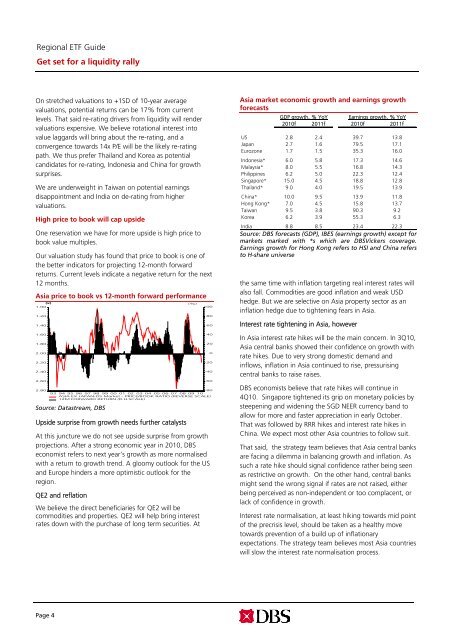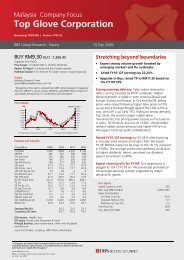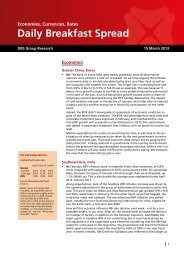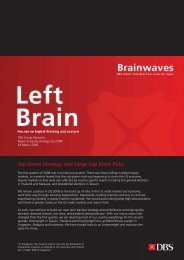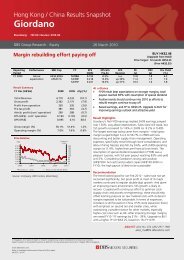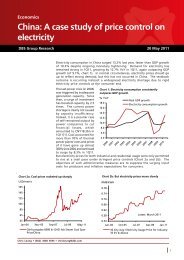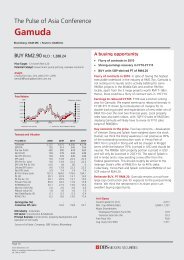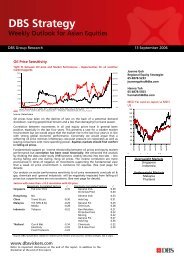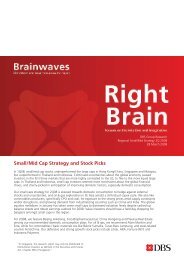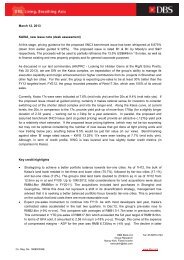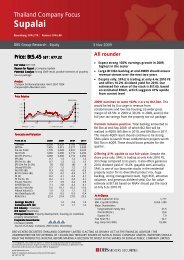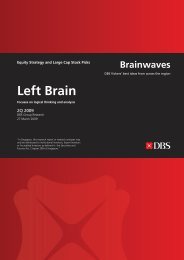Get set for a liquidity rally - the DBS Vickers Securities Equities ...
Get set for a liquidity rally - the DBS Vickers Securities Equities ...
Get set for a liquidity rally - the DBS Vickers Securities Equities ...
Create successful ePaper yourself
Turn your PDF publications into a flip-book with our unique Google optimized e-Paper software.
Regional ETF Guide<br />
<strong>Get</strong> <strong>set</strong> <strong>for</strong> a <strong>liquidity</strong> <strong>rally</strong><br />
On stretched valuations to +1SD of 10-year average<br />
valuations, potential returns can be 17% from current<br />
levels. That said re-rating drivers from <strong>liquidity</strong> will render<br />
valuations expensive. We believe rotational interest into<br />
value laggards will bring about <strong>the</strong> re-rating, and a<br />
convergence towards 14x P/E will be <strong>the</strong> likely re-rating<br />
path. We thus prefer Thailand and Korea as potential<br />
candidates <strong>for</strong> re-rating, Indonesia and China <strong>for</strong> growth<br />
surprises.<br />
We are underweight in Taiwan on potential earnings<br />
disappointment and India on de-rating from higher<br />
valuations.<br />
High price to book will cap upside<br />
One reservation we have <strong>for</strong> more upside is high price to<br />
book value multiples.<br />
Our valuation study has found that price to book is one of<br />
<strong>the</strong> better indicators <strong>for</strong> projecting 12-month <strong>for</strong>ward<br />
returns. Current levels indicate a negative return <strong>for</strong> <strong>the</strong> next<br />
12 months.<br />
Asia price to book vs 12-month <strong>for</strong>ward per<strong>for</strong>mance<br />
1.00<br />
1.20<br />
1.40<br />
1.60<br />
1.80<br />
2.00<br />
2.20<br />
2.40<br />
2.60<br />
(x)<br />
2.80 -80<br />
93 94 95 96 97 98 99 00 01 02 03 04 05 06 07 08 09 10<br />
ASIA EX JAPAN-DS Market - PRICE/BOOK RATIO (REVERSE SCALE)<br />
12M FORWARD RETURN (R.H.SCALE)<br />
Source: Datastream, <strong>DBS</strong><br />
(%)<br />
100<br />
80<br />
60<br />
40<br />
20<br />
0<br />
-20<br />
-40<br />
-60<br />
Source: DATASTREAM<br />
Upside surprise from growth needs fur<strong>the</strong>r catalysts<br />
At this juncture we do not see upside surprise from growth<br />
projections. After a strong economic year in 2010, <strong>DBS</strong><br />
economist refers to next year’s growth as more normalised<br />
with a return to growth trend. A gloomy outlook <strong>for</strong> <strong>the</strong> US<br />
and Europe hinders a more optimistic outlook <strong>for</strong> <strong>the</strong><br />
region.<br />
QE2 and reflation<br />
We believe <strong>the</strong> direct beneficiaries <strong>for</strong> QE2 will be<br />
commodities and properties. QE2 will help bring interest<br />
rates down with <strong>the</strong> purchase of long term securities. At<br />
Asia market economic growth and earnings growth<br />
<strong>for</strong>ecasts<br />
GDP growth, % YoY Earnings growth, % YoY<br />
2010f 2011f 2010f 2011f<br />
US 2.8 2.4 39.7 13.8<br />
Japan 2.7 1.6 79.5 17.1<br />
Eurozone 1.7 1.5 35.3 16.0<br />
Indonesia* 6.0 5.8 17.3 14.6<br />
Malaysia* 8.0 5.5 16.8 14.3<br />
Philippines 6.2 5.0 22.3 12.4<br />
Singapore* 15.0 4.5 18.8 12.8<br />
Thailand* 9.0 4.0 19.5 13.9<br />
China* 10.0 9.5 13.9 11.8<br />
Hong Kong* 7.0 4.5 15.8 13.7<br />
Taiwan 9.5 3.8 90.3 9.2<br />
Korea 6.2 3.9 55.3 6.3<br />
India 8.8 8.5 23.4 22.3<br />
Source: <strong>DBS</strong> <strong>for</strong>ecasts (GDP), IBES (earnings growth) except <strong>for</strong><br />
markets marked with *s which are <strong>DBS</strong><strong>Vickers</strong> coverage.<br />
Earnings growth <strong>for</strong> Hong Kong refers to HSI and China refers<br />
to H-share universe<br />
<strong>the</strong> same time with inflation targeting real interest rates will<br />
also fall. Commodities are good inflation and weak USD<br />
hedge. But we are selective on Asia property sector as an<br />
inflation hedge due to tightening fears in Asia.<br />
Interest rate tightening in Asia, however<br />
In Asia interest rate hikes will be <strong>the</strong> main concern. In 3Q10,<br />
Asia central banks showed <strong>the</strong>ir confidence on growth with<br />
rate hikes. Due to very strong domestic demand and<br />
inflows, inflation in Asia continued to rise, pressurising<br />
central banks to raise raises.<br />
<strong>DBS</strong> economists believe that rate hikes will continue in<br />
4Q10. Singapore tightened its grip on monetary policies by<br />
steepening and widening <strong>the</strong> SGD NEER currency band to<br />
allow <strong>for</strong> more and faster appreciation in early October.<br />
That was followed by RRR hikes and interest rate hikes in<br />
China. We expect most o<strong>the</strong>r Asia countries to follow suit.<br />
That said, <strong>the</strong> strategy team believes that Asia central banks<br />
are facing a dilemma in balancing growth and inflation. As<br />
such a rate hike should signal confidence ra<strong>the</strong>r being seen<br />
as restrictive on growth. On <strong>the</strong> o<strong>the</strong>r hand, central banks<br />
might send <strong>the</strong> wrong signal if rates are not raised, ei<strong>the</strong>r<br />
being perceived as non-independent or too complacent, or<br />
lack of confidence in growth.<br />
Interest rate normalisation, at least hiking towards mid point<br />
of <strong>the</strong> precrisis level, should be taken as a healthy move<br />
towards prevention of a build up of inflationary<br />
expectations. The strategy team believes most Asia countries<br />
will slow <strong>the</strong> interest rate normalisation process.<br />
Page 4


